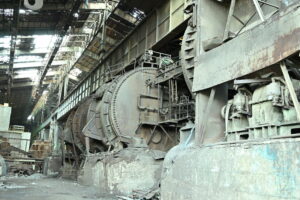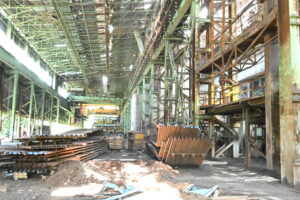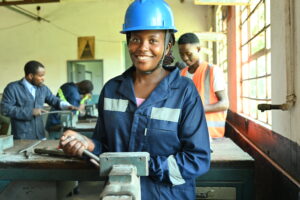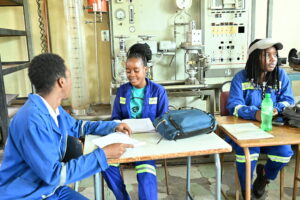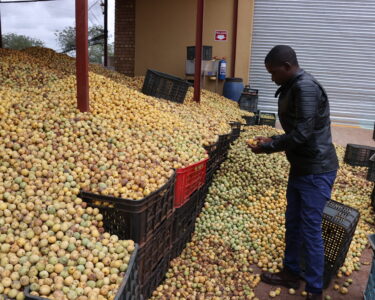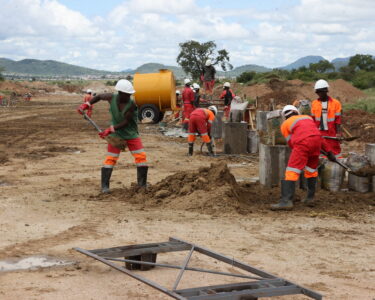Whenever the story about the former steelmaking giant, Ziscosteel, is told there is overwhelming focus on the efforts being made to revive the company. A number of investors have bid to revive the company, but after raising people’s expectations, they pulled out leaving many people disappointed. Remember the much-hyped Essar Africa Holdings deal that collapsed at the last minute in 2011? This was followed six years later by the equally ill-fated US$2 billion proposed investment by China’s R & F.
While the false starts have made newspaper headlines, very little or nothing has been written about Ziscosteel’s hugely successful training programme. As our reporter Elias Chakanyuka recently found out, Ziscosteel’s Training Centre has everything that is required to provide on-the-job training to artisans in various technical fields in line with the National Development Strategy 1 (NDS1). Established in 1964, the centre has continued to run long after the blast furnaces stopped belching out tonnes of smoke into the Midlands’ sky. It turns out that Ziscosteel, in fact, never died. Read on . . .

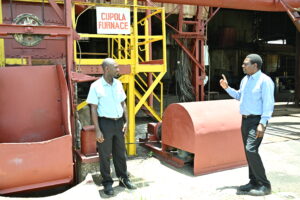
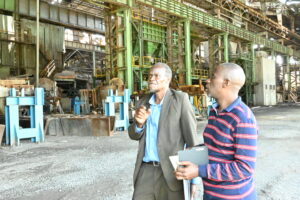
In Kuvimba, we trust
After many false starts, it looks like the Second Republic has finally found the right formula to revive Ziscosteel, which was close to half a century the pulse of the Midlands Province employing over 5 000 people. Of course, when one is confronted with the rusty and old steel plants at its Redcliff base, it would appear as if Kuvimba Mining House is about to pour millions into a bottomless pit. But those who have served Ziscosteel faithfully over the years have no reason to doubt that the long wait is over. In Kuvimba, they trust. After all, kuvimba is the Shona word for trust or faith . . .
The indigenous-owned company has already injected US$300 million to kick-start the refurbishment of Ziscosteel. And those familiar with its impeccable track record agree that the nation has every reason to celebrate. The evidence is there for all to see. Kuvimba Mining House may be “the new kid on the block”, so to speak, but it has already successfully resuscitated moribund mines such as Bindura Nickel, Jena and Shamva gold mines, among others. They know that failure is not an option and that Zimbabweans, in general, and the people of Midlands, in particular, cannot wait to see the former steel giant back in business.
Since Ziscosteel is a national asset and Kuvimba Mining House an indigenous company, Zimbabweans from all walks of life want to see action — nyika ichivakwa nevene vayo. No more, and no less. For its part, Kuvimba Mining House has pledged to secure modern technologies capable of producing high-grade steel which will turn the company into a market leader in Southern Africa and beyond.
Since “hearsay” is a four-letter word in our lexicon, the Brick by Brick magazine team went on a mission to explore the situation on the ground at Ziscosteel. Admittedly, from the outside, Ziscosteel looks as dead as the proverbial dodo. But there is a fascinating story that has been kept out of the public glare that could earn a revamped Ziscosteel the title of “regional superpower” in terms of skills development, building on STEM (Science, Technology, Engineering and Mathematics).
Talk about killing two birds with one stone!
On hand to take Brick by Brick on a tour of the partly deserted Zisco premises was the human resources and training manager, Norman Chibwe, who was standing in for the group chief executive officer, Dr Farai Karonga. To complete the entourage were the works executive, Elphas Mahachi, and the acting public relations manager, Sebastian Manyika.
Ziscosteel’s best kept secret
Chibwe got the ball rolling in his capacity as human resources and training manager.
Says Chibwe: “The Ziscosteel Training Centre has been in existence since 1964. The complex has nine lecture rooms, three machine shops, one fabrication/boilermaking workshop, one automotive/motor mechanic workshop, one instrumentation and control workshop and one electrical and electronics workshop. All the lecture rooms and workshops are fitted with the basic infrastructure and equipment in tandem with their specific purposes.
“The Training Centre was established to provide training for company employees at all levels to ensure they are equipped with the requisite skills, attitudes and knowledge to perform their duties effectively. The overarching goal is to enhance organisational productivity; to periodically carry out needs analysis to identify skills gaps and the related interventions as well as opportunities that are aligned with and support the business needs; to develop and maintain an internal skills pipeline by identifying and fostering the skills development of capable junior level employees so as to meet current and future business needs.
“In addition, the centre was established to reinforce the organisation’s existing skills and knowledge and to identify potential bursary and sponsorship opportunities for university undergraduate candidates in the relevant engineering disciplines to be funded by the company to augment the existing management and technical manpower skills on completion of their studies.
“During Ziscosteel’s heyday, the Training Centre also offered supervisory and management, operatives and apprenticeship training, in support of the company’s core mandate of producing iron and steel. However, apprenticeship training was the flagship and offered training in the following disciplines: electrical, fitting and turning, machining/turning, instrumentation and control, radio communication, fabrication, welding, armature winding, auto-electrics, diesel plant fitting, motor mechanics, carpentry, bricklaying, refrigeration and air-conditioning, rigging, plumbing, blacksmithing, patternmaking and roll turning.
“The last group of apprentices and graduate trainees to qualify from the Ziscosteel Training Centre was in 2014, even though iron and steel production had ceased in 2008. Altogether, over 6 000 artisans, technicians and graduate engineers have qualified from the Ziscosteel Training Centre. The success story of the said programmes was underpinned by the then vibrant Ziscosteel plant which provided the trainees with the necessary on-the-job training exposure.
“Ziscosteel Training Centre has continued with its mandate of providing critical skilled manpower to the nation in line with NDS1. However, the focus has now shifted from the traditional programmes to include empowerment of the youth in the mainstream engineering disciplines as well as providing attachment placements for university undergraduates, polytechnic and technical vocational students in line with the national skills agenda.
“Once the plant is up and running, the capacity to train for our internal needs, let alone for the nation, is enormous. In the interim, management thought we could utilise the Training Centre to generate some income. It was also in line with our corporate social responsibility to the Midlands community and the nation at large. There are many school-leavers out there who are not gainfully employed, with no particular skills set – so instead of the facility being idle, we opened it to the public for a token fee.
“Since the token fees are not enough to meet the costs of running the Training Centre, it has since 2008 been surviving on sales of scrap and sundry products.
“The Training Centre has since established an Engineering Skills Upgrading Programme, which is in sync with the Ministry of Higher and Tertiary Education, Science and Technology’s Integrated Skills Expansion Outreach Programme. In view of the heavy investment in machinery at the Training Centre, it was prudent to continue utilising it even in the absence of production at the main plant.
“The main objectives of the Engineering Skills Upgrading Programme is to empower mostly the youths and other interested individuals with core engineering skills in electrical power, fitting and turning, machining/turning, instrumentation and control, fabrication, welding, auto-electrics, diesel plant fitting, rigging and plumbing; and to provide relevant engineering skills for sustainable economic development.
“In addition, the programme seeks to ensure that the youth enjoy lifelong employability through upskilling and reskilling; to address the youth unemployment problems by providing the technical and entrepreneurial skills to enable them to start their own businesses and be employers in their own right and to empower other interested individuals apart through the provision of employable engineering skills for the sustainable development of the economy.
“Since the inception of the Engineering Skills Upgrading Programme in 2020, around 1 500 people, mainly youths, have successfully gone through the programme. Worth noting is the fact that almost 50% of the participants are females, thus demystifying the myth that engineering is a male domain.
“The success level of our students in the theory and practical trade tests administered by the Ministry of Higher and Tertiary Education, Science and Technology’s ITTD Department is very encouraging given the weak academic backgrounds of some of our students.”
Chibwe added that although most all the machinery and equipment has seen no less than 30 years’ service, it was still in reasonable working condition for training purposes.
“Resources permitting, we plan to procure some critical spares for the overhaul and repair of some of the machines to align them with the growing numbers of students taking up the programme and changing technology. It’s also important to note that whilst all the workshops are equipped with the basic equipment and machinery for training apprentices and semi-skilled personnel, the success of such programmes is dependent on the availability of the requisite tools and consumables as well as instructors,” explained Chibwe.
The human resources and training manager has no doubt that despite not producing any steel for the last 15 years, Ziscosteel continues to make a significant contribution to Vision 2030.
“In Zimbabwe, we are probably one of the biggest contributors in terms of skilled manpower development. Right now, we are working closely with the Ministry of Higher and Tertiary Education’s Trade Testing Department. They do their practical tests here at the training centre. We are a conduit for skills, not only for Zisco but the nation at large,” he says.
“For the Engineering Skills Development Programme, we are not strict when it comes to Maths, English and Science qualifications. There is a tendency to write off some school-leavers who failed their O-Levels. But, to everyone’s surprise, the majority of the ‘unqualified’ students we have enrolled here performed exceptionally well. With that empowerment, they are now in a position to look after themselves and their families. This is because there is some dissonance between the academic and practical side of things.
“Our intake averages around 300 students. Some are fresh from school, while a sizeable number have already passed through the programme and are seeking to sharpen their skills to a higher level.
“A lot is happening behind the scenes”
Chibwe was optimistic now that Kuvimba Mining House had injected US$300 million into Ziscosteel, the era of false starts was over. “As many as nine companies had showed interest in turning around Ziscosteel’s fortunes, but in the final analysis it Kuvimba Mining House that got the nod.
“By end of December 2022, Kuvimba Mining House had met all the conditions as stipulated by government and thus became Ziscosteel’s official technical partner. The partnership is a management contract which will run for five years. Kuvimba is currently carrying out due diligence and detailed scoping of the project in order to come up with a comprehensive strategic plan to get Ziscosteel back on track.
“There is obviously a lot happening behind the scenes. This follows a directive from His Excellency, President Mnangagwa, that Ziscosteel should be revived at all costs. A taskforce has been put in place to oversee its resuscitation. We are grateful to the President and Cabinet for ensuring that Ziscosteel got a technical partner.
“Ziscosteel was, and is still expected to be, the pulse of the Midlands Province. The community is excited and really looking forward to seeing this sleeping giant enjoying a new lease of life. We are excited because for the first time, we have an indigenous partner, Kuvimba Mining House. They understand the situation and the strategic importance of Ziscosteel much better than foreigners.
“I am very optimistic that this time the government has nailed it. Yes, it has taken a long time, but I thank the President for setting up a ministerial taskforce dedicated to reviving ZIscosteel. That alone is a confirmation that we can’t go wrong; we cannot afford to go wrong. This is the brick-by-brick approach that the President is always talking about. The papers have already been signed and the initial injection of US$300 million is proof that the Second Republic really means business,” concluded Chibwe.




